The Employees’ Provident Funds and Miscellaneous Provisions Act,1952
The Employees’ Provident Funds and Miscellaneous Provisions Act,1952. EPF Act,1952. The EPF Scheme was framed under Section 5 of the Act which came into force on 1 st November,1952.
Share Presentation
Embed Code
Link
Download Presentation
- government securities
- central government
- provident fund organization
- minimum
- regional provident fund commissioner
- upto rs

keaton + Follow
Download Presentation
The Employees’ Provident Funds and Miscellaneous Provisions Act,1952
An Image/Link below is provided (as is) to download presentation Download Policy: Content on the Website is provided to you AS IS for your information and personal use and may not be sold / licensed / shared on other websites without getting consent from its author. Content is provided to you AS IS for your information and personal use only. Download presentation by click this link. While downloading, if for some reason you are not able to download a presentation, the publisher may have deleted the file from their server. During download, if you can't get a presentation, the file might be deleted by the publisher.
Presentation Transcript
- The Employees’ Provident Funds and Miscellaneous Provisions Act,1952
- EPF Act,1952 The EPF Scheme was framed under Section 5 of the Act which came into force on 1st November,1952. The Act is applicable to Factories and other Establishments which have completed three years of their existence and employing 20 or more persons.
- EPF Act,1952 The Act does not apply to cooperative societies employing less than 50 persons and working without the aid of power. Once the Act is applied, it does not cease to be applicable even if the number of employees falls below 20.
- EPF Act,1952 An establishment/factory, which is not coverable under the Act can be covered voluntarily with the mutual consent of the employer and the majority of the employees u/s 1(4) of the Act. Employees drawing a pay not exceeding Rs.6500/- per month are eligible for membership of the fund from the date of joining the factory or establishment.
- Contribution The normal rate of contribution to the Provident Fund by the employees and the employers, as prescribed in the Act, is 10% of the pay of the employees. The contribution received by the Provident Fund Organization from unexempted establishments as well as by the Board of Trustees from exempted establishments shall be invested, after making payments on account of advances and final withdrawals, according to pattern laid down by the Govt. of India from time to time.
- Contribution The exempted establishments are required to follow the same pattern of investment as is prescribed for the unexempted establishments.
- Where accumulations are invested? government securities, negotiable securities or bonds, national savings certificates or post office time deposit and special deposit schemes, if any.
- Rate of Interest Under Para 60(1) of the EPF Scheme, the Central Govt., on the recommendation of the Central Board of Trustees, declares the rate of interest to be credited annually to the accounts of Provident Fund Subscribers.
- Other Provisions Under the Scheme, a member may withdraw the full amount standing to his credit in the fund in the event of…. Retirement from service after attaining the age of 55. Retirement on account of permanent and total incapacity. Migration from India for permanent settlement abroad and Termination of Service in the course of mass retrenchment
- Other Provisions If there is no nominee, the amount shall be paid to the members of his family in equal shares except: Sons who have attained majority; Sons of a deceased son who have attained the age of majority; Married daughters whose husbands are alive; Married daughters of a deceased son whose husbands are alive.
- Other Provisions The nomination form shall be filled in duplicate and one copy duly accepted by the Provident Fund Office, will be kept by members. In case of change, a separate form for a fresh nomination should be filled in duplicate. When a member leaves service in one establishment and obtains re-employment in another establishment, whether exempted or unexempted, in the same region or in another region, he is required to apply for the transfer of his provident fund account to the Regional Provident Fund Commissioner in the prescribed form.
- Other Provisions The Scheme provides for non-refundable withdrawals to meet certain contingencies: Financing of Life Insurance Policies House Building Purchasing shares of consumers cooperative credit housing societies During temporary closure of establishment Illness of member, family members; Member’s own marriage or for the marriage of his/her sister, brother or daughter/son and post matriculation education of children
- Other Provisions Damages to movable and immovable property of members due to a calamity. Unemployment relief to individual retrenchee member. Cut in supply of electricity to the factory/establishment and Grant of advance to members who are physically handicapped for the purchase of equipment
- Other Provisions As soon as possible after the completion of each accounting year, every member of the fund shall be supplied with an account slip showing: The opening balance The amount contributed during the year The amount of interest credited or debited during the year and Closing balance. Errors, if any, should be brought to the notice of the Commissioner within six months.
- Other Provisions The Central Govt. is empowered to grant exemption to any establishments from the operation of the Act for a specified period, on financial year or other grounds u/s.16(2). The exemption is granted by an issue of notification in the official gazette and subject to such terms and conditions may be specified in the notification. The exemption does not amount to total exclusion from the provisions of the Act.
- Other Provisions The exempted establishment are required to constitute Board of Trustees according to the rules governing the exemptions to administer the fund, subject to overall control of the Regional Provident Fund Commissioner. The exempted establishments are also required to maintain proper accounts, submit prescribed returns, invest provident fund accumulations in the manner prescribed by the Central Govt from time to time and to pay inspection charges. Exemption is liable to be cancelled for breach of any of these conditions.
- The employees’ pension scheme,1995
- EPS,1995 The Employees Pension scheme is compulsory for all persons who were members of the Family Pension Scheme,1971. It is also compulsory for the persons who have become members of the Provident Fund from 16-11-1995 i.e. the date of introduction of the scheme.
- EPS,1995 The Provident Fund Subscribers who were not members of the Family Pension Scheme, have an option to joint the Pension Scheme. The Scheme came into operation w.e.f 16-11-1995.
- ELIGIBILITY Minimum 10 years contributory service is required for entitlement to pension. Normal superannuation pension is payable on attaining the age of 58 years. Pension on a discounted rate is also payable on attaining the age of 50 years.
- ELIGIBILITY When pensionable service is less than 10 years, the member has an option to remain covered for pensionary benefits till 58 years of age or claim return of contribution/withdrawal benefits.
- BENEFITS The Scheme provides for payment of monthly pension in the following contingencies. Superannuation on attaining the age of 58 years. Retirement Permanent total disablement Death during services Death after retirement/superannuation/ permanent total disablement. Children pension Orphan pension
- BENEFITS The amount of monthly pension will vary from member to member depending upon his pensionable salary and pensionable service. Pensionable Salary X (Pensionable Service+2) ----------------------------------------------------------------- 70 Per Month member’s pension will come Pensionable Salary will be average of last 12 month’s pay
- Provisions relating to the Family Pension The rate of minimum widow pension is Rs.450 pm. The maximum may go upto Rs.2500/pm payable as normal member’s pension on completion of nearly 33 years’ service. Family Pension upto Rs.1750/pm is also payable to the widow of the member who has contributed only for one month to the pension fund.
- Provisions relating to the Family Pension In addition to the widow pension, the family is also entitled to children pension. The rate of children pension, the family is also entitled to children pension. The rate of children pension is 25% of widow pension for each child subject to minimum of Rs.150/-pm per child payable upto two children at a time till they attain the age of 25 years.
- Provisions relating to the Family Pension If there are no parents alive, the scheme provides for orphan pension at the rate of 75% of the widow pension payable to orphans subject to the minimum of Rs.250/-pm per orphan.
- Option for Return of Capital Under the Employees’ Pension Scheme, the employees have an option to accept the admissible pension or reduced pension with return of capital . In the case of the employees opting for 10% less pension than the actual entitlement, the scheme provides for return of capital equivalent to 100 times of the original pension in the event of death of the pensioner.
- FINANCE Under the Scheme, neither the employer nor the employee is required to make additional contribution. A Pension Fund has been set up and from 16-11-1995, the employer’s share of provident fund contribution representing 8.33% of the wage is being diverted to the said Fund. The Central Govt is also contributing to the Pension Fund at the rate of 1.16% of the wage of the employees.
- FINANCE The Central Govt’s contribution from 16-11-1995 onwards are invested in the PUBLIC ACCOUNT OF THE GOVT. OF INDIA. Other accumulations to the pension fund are being invested as per the pattern prescribed by the Ministry of Finance from time to time.
- The employees’ deposit linked insurance scheme,1976
- EDLIS The Scheme came into force from 1st August,1976. It is applicable to all Factories/ Establishments to which the EPF Act,1952 applies. All the provident fund member-employees, both in exempted and unexempted establishments are covered under this Scheme.
- EDLIS While the employees are not required to contribute to the Insurance Fund, the employers are required to pay contributions to it at the rate of 0.5% of the pay of the employees who are provident fund subscribers.
- EDLIS Central Government also contributes to the Insurance Fund at the rate of 0.25% of the pay in respect of the covered employee. The employers are also required to pay administration charges to the Insurance Fund at the rate of 0.01% of the pay drawn by the employees, subject to a minimum of Rs.2/- per month.
- EDLIS The Central Government also meets partly the expense in connection with the administration charges to the Insurance Fund at the rate of 0.005% of the pay drawn by the employee members subject to a minimum of Rs.1/- per month.
- EDLIS Contribution received in the Insurance Fund are kept in the Public Account of the Government of India. There is provision in the scheme for the exemption of factories/establishments which have an Insurance Scheme approved by the Government and conferring more benefits than those provided under this Statutory Scheme.
- THANK YOU Bhagyesh M. Dave
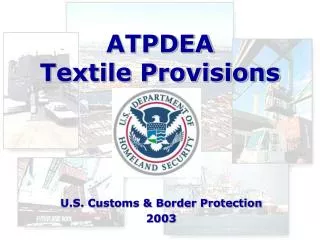
ATPDEA Textile Provisions
ATPDEA Textile Provisions. U.S. Customs & Border Protection 2003. Andean Trade Promotion and Drug Eradication Act. H.R. 3009 Public law 107-210 Signed into law on August 6, 2002 Effective on October 1, 2002 Will expire on December 31, 2006
1.49k views • 105 slides

How to Deal with Problem Employees
How to Deal with Problem Employees. CHAPTER OVERVIEW. The chapter identifies common types of problem behavior among employees . Those most likely to be encountered by supervisors are absenteeism and tardiness, insubordination and uncooperativeness, . Methods.
1.57k views • 47 slides
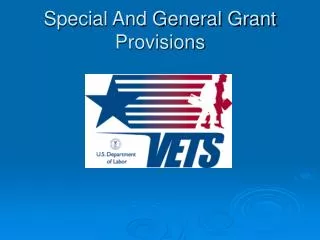
Special And General Grant Provisions
Special And General Grant Provisions. HVRP General and Special Grant Provisions. Are the terms and conditions of the grant award – “the fine print”. Mailed to the grantees along with the grant award documentation. I. Administrative Provisions
1.39k views • 97 slides
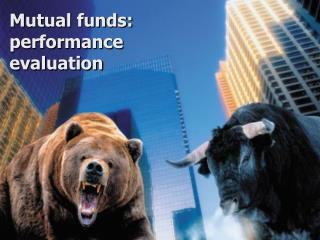
Mutual funds: performance evaluation
Mutual funds: performance evaluation. Worldwide TNA of mutual funds. Worldwide # mutual funds. Open-end mutual funds. Active vs passive (index) funds Obliged to buy/sell shares at NAV Net Asset Value = Total Net Assets (TNA) per share
1.46k views • 69 slides

HVRP General and Special Grant Provisions
HVRP General and Special Grant Provisions. Are the terms and conditions of the grant award – “the fine print”. Mailed to the grantees along with the grant award documentation. I. Administrative Provisions Where all of the applicable Code of Federal Regulations are referenced.
1.21k views • 57 slides

EMPLOYEES’ PROVIDENT FUNDS AND MISCELLANEOUS PROVISIONS ACT, 1952
EMPLOYEES’ PROVIDENT FUNDS AND MISCELLANEOUS PROVISIONS ACT, 1952. Presented by : . Foreword. The employees provident funds and miscellaneous act,1952: is a piece of social legislation a beneficent measure,
2.38k views • 81 slides

ELECTRICITY ACT 2003 ANTI THEFT PROVISIONS
ELECTRICITY ACT 2003 ANTI THEFT PROVISIONS. BY K. DURGA PRASAD, IPS JOINT MANAGING DIRECTOR APTRANSCO, HYDERABAD. FEDERATION OF INDIAN CHAMBERS OF COMMERCE AND INDUSTRY, NEW DELHI 23-07-2003 . PROVISIONS. Entry, Search and Seizure Penal Action for Theft Abetment Assessment
1.36k views • 17 slides

Beckmann, M.J., 1952, "A continuous model of transportation", Econometrica 20:642-660.
Beckmann, M.J., 1952, "A continuous model of transportation", Econometrica 20:642-660. Beckmann, M. J. 1953, "The partial equilibrium of a continuous space economy", Weltwirtschaftliches Archiv 71:73-89. Beckmann, M.J., 1952, "A continuous model of transportation", Econometrica 20:642-660.
979 views • 68 slides
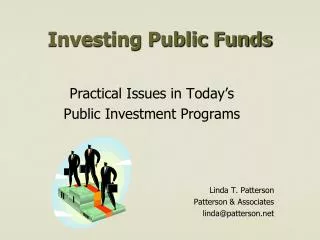
Investing Public Funds
Investing Public Funds. Practical Issues in Today’s Public Investment Programs Linda T. Patterson Patterson & Associates linda@patterson.net. A Public Investor. Special fiduciary duties for public funds: market and internal entity knowledge to understand risk to be conservative
2.23k views • 208 slides
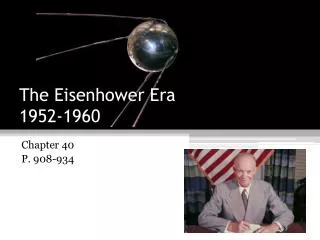
The Eisenhower Era 1952-1960
The Eisenhower Era 1952-1960. Chapter 40 P. 908-934. Dwight David Eisenhower. Born in Texas Raised in Abilene, Kansas West Point grad 1915 WWI served as instructor in military camps Aide to Douglas MacArthur 1941 Brigadier General Organizational ability and tact earned him
1.09k views • 92 slides

Mutual Fund
Mutual Fund. Investor Perspective. Risk Aversion. Risk Management. Mutual Funds. Bank Deposits, PPF, NSC, Insurance, Kisan Vikas Patra etc. Basics of Investments:. Low Risk/Low Return. Managed Risk/High Return. Myths about Mutual Funds. 1. Mutual Funds invest only in shares.
1.21k views • 91 slides
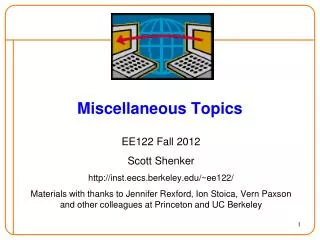
Miscellaneous Topics
Miscellaneous Topics. EE122 Fall 2012 Scott Shenker http:// inst.eecs.berkeley.edu /~ee122/ Materials with thanks to Jennifer Rexford, Ion Stoica , Vern Paxson and other colleagues at Princeton and UC Berkeley. Q/A on Project 3. Today’s Lecture: Dim Sum of Design. Quality -of-Service
846 views • 76 slides

Pollution: 1952 London Smog Disaster
Krista Scarboro May 14, 2014 Amanda Freeman Environmental Disaster Project. Pollution: 1952 London Smog Disaster. Background. Types of Ecosystems: Smoke that covered the city like fog. Population Size: 80,000 Historical References:
1.96k views • 8 slides

Miscellaneous:
Miscellaneous:. - We will be going directly back to campus - After a few relief stops - Check for final launch NO/GO status at 303-492-4750 after 9:00 PM Friday Lost, running late, call 303-378-4765 . Gateway To Space ASEN / ASTR 2500 Class # 22. T -2. Colorado Space Grant Consortium.
953 views • 85 slides

INVESTING SCHOOL FUNDS Public Funds Investment Act Workshop
INVESTING SCHOOL FUNDS Public Funds Investment Act Workshop. Region 1 –Edinburg July 2014. 1987: Separating Banking and Investing. Local governments – except home rule entities – were bank dependent Before most entities were restricted to bank accounts and CDs
2.29k views • 215 slides

DEPRECIATION,PROVISIONS & RESERVES
DEPRECIATION,PROVISIONS & RESERVES. CONTENTS. 1 CONCEPT OF DEPRECIATION 2 CAUSES OF DEPRECIATION 3 NEED OF DEPRECIATION 4 BASIC FACTORS 5 METHODS OF DEPRECIATION 6 PROVISION AND RESERVES. DEFINITION.
2.44k views • 60 slides

Start
Sinop Spastik Çocuklar Derneği. ADAWEB. Adaption of Disabled Employees to Work Enviroment Project. Start. This CD provides information for disabled employees, employers and other employees about employment of disabled people. ADAWEB. For Employers. For Other Employees.
3k views • 277 slides

How to Get/ Obtain European Funds?
How to Get/ Obtain European Funds?. GRU-o9-GRAT-13-IS Iaşi, Nov 2009, Trainer: Cristina Cherţ. How to get European Funds?. Anticip ate Formalize Accomplish / Realize Create and use package of necessary tools / use the convenient set of knowledge! Optimize your approach.
1.08k views • 93 slides

The U.S.A. – A History 1945 – 1952
The U.S.A. – A History 1945 – 1952. The Atomic Bomb Hiroshima and Nagasaki - 1945.
1k views • 84 slides
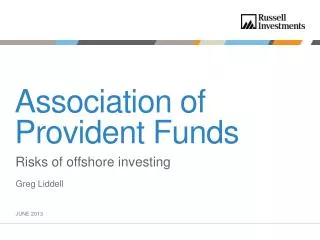
Association of Provident Funds
Association of Provident Funds. Risks of offshore investing. JUNE 2013. Greg Liddell. Benefits of Overseas Investing. Access to different companies and sectors Diversification of economic/growth cycle Diversification of interest rate cycle Benefits of currency diversification
1.11k views • 60 slides






















